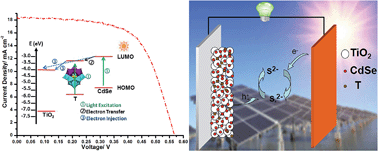The improved efficiency of quantum-dot-sensitized solar cells with a wide spectrum and pure inorganic donor–acceptor type polyoxometalate as a collaborative cosensitizer†
Abstract
Quantum dot sensitized solar cells with high theoretical conversion efficiency, low production cost and a simple production process have received great attention in recent years. For CdSe-sensitized cells, the most significant defect of CdSe is that it has the weak absorption between 550 and 600 nm and no absorption after 650 nm, so it is crucial to find a wide spectrum photosensitizer to make up for the defect. Here, wide spectrum and pure inorganic Donor–Acceptor (D–A) Type Polyoxometalate (POM) K6H4[α-SiW9O37Co3(H2O)3]·17H2O (denoted as T) is firstly introduced into QDSCs as a collaborative cosensitizer with CdSe. The T has a visible characteristic peak centering between 550 and 600 nm, and also has stronger absorption after 650 nm, which could make up for the defect of CdSe to constitute a wide spectrum of absorption. The fluorescence spectrum, surface photovoltage spectrum, ultraviolet photoelectron spectroscopy spectrum and solid diffuse spectrum were used to explore the photosensitivity of T. In addition, the D–A type POM can act as a good intermediate for the injection of electrons and improve the visible photocurrent response; meanwhile, it can obviously reduce the dark current and increase the electron lifetime, which can solve the problem about the high recombination at the QD/TiO2/electrolyte interface. In general, the best photovoltaic performance of T and CdSe cosensitized solar cells is increased to 6.59% (Jsc = 18.37 mA cm−2, Voc = 0.57 V, FF = 0.63), which is improved by 32.33% compared to those of the pure CdSe-sensitized cells (Jsc = 16.20 mA cm−2, Voc = 0.50 V, FF = 0.61, η = 4.98%).


 Please wait while we load your content...
Please wait while we load your content...